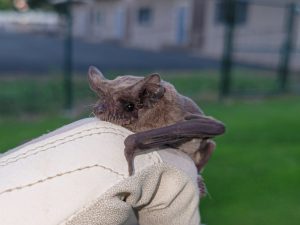Owls, Bats, Moths, & Nighthawks of South San Jose
October 30, 2025
In the South Bay, twilight brings out a cast of nocturnal performers:

Mexican Free-Tailed Bat being released.
Photo fromNorCalBats website
Barn Owl (Tyto alba) – In colors of blonde and white, these owls soar silently over open fields and creek corridors, hunting rodents that thrive in our suburban landscapes. Strategically placed barn-owl nest boxes can offer excellent safe havens for this species.
Common Poorwill – One of the nighthawks, they arrive each spring to nest in open spaces throughout the county. They are hard to spot as they dart through the night sky chasing insects. Their distinctive, radar-like calls are often what alert you to their presence.
Bats – California’s native bats emerge at dusk, feasting on mosquitoes and moths. A single bat can eat up to a thousand insects an hour, making them nature’s best pest control. Their insect-eating expertise saves California farmers millions of dollars in pest management each year.
Moths – Often overlooked next to their daytime cousins, butterflies, moths are crucial nighttime pollinators. As they visit night-blooming flowers, they carry pollen that supports native plants, fruits, and foods that birds and other wildlife depend on. Many baby birds rely on moth caterpillars as their primary source of protein, making moths an invisible link in the circle of life.
Great Horned Owl (Bubo virginianus) – No discussion of nocturnal wildlife would be complete without the Great Horned Owl, the powerful predator whose rhythmic “hoo-hoo-hoo-hoo” is the quintessential owl call often heard in fall as they search for a mate. Year-round residents of the Bay Area, they nest in tall trees, usually re-purposing old crow or hawk nests. Their diet includes rabbits, skunks, and rodents, helping keep our ecosystems balanced.
Keeping Night Flyers Safe
- Don’t use sticky traps! They can kill bats, hummingbirds, and other flying species that get stuck on the glue.
- Avoid rodenticides. Rodents that consume these poisons are easily caught in their weakened state and then eaten by owls and hawks — often killing these beautiful predator species.
- Choose wildlife-friendly Halloween decorations. Avoid fake spider webs, which can entangle owls and other birds, causing broken wings and death if not rescued in time.
How Night-Active Species Help the Ecosystem
While we sleep, the night shift of the natural world is hard at work. Together, these night flyers form a natural pest-control network that reduces the need for chemicals and keeps ecosystems healthy.
- Bats keep insect populations under control.
- Owls manage rodents that can damage gardens or spread disease.
- Nighthawks consume flying insects other birds ignore.
- Opossums, skunks, and raccoons keep grub and rat populations in check.
Evening Bird Walks: Listening to the Night
With the shorter days, evening bird walks become more accessible. Imagine standing in a quiet meadow as dusk settles: a bat dips overhead, a silent barn owl glides past, frogs sing, and the distant “whoo-hoot” of a Great Horned Owl meets your ears. If you’ve never tried a listening walk, we invite you to bring a flashlight with a red filter — and your sense of curiosity.
Create a Night-Friendly Backyard Habitat
At the Los Gatos Birdwatcher, we encourage lighting and habitat choices that invite nocturnal wildlife rather than scare it away. Try these ideas:
-
Use low-light decorative solar lighting instead of harsh motion-activated floodlights.
-
Install an owl box or bat box to offer safe nesting and roosting sites.
-
Explore books on bats, owls, and nocturnal wildlife to learn how to make your yard more wildlife-friendly.
Upcoming Event--Nov 15: Bats Visit Our Store
Don’t miss our upcoming NorCalBats event at the store, featuring live bats and discussions about local bat species, their benefits, and conservation tips. Drop by the store anytime from 10:30 a.m. – 1:30 p.m. on November 15, 2025 to meet the bats!



